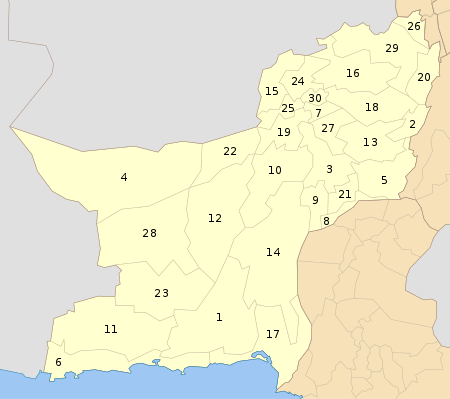Economy of the Federally Administered Tribal Areas
-38547.jpg)
The economy of the Federally Administered Tribal Areas is relatively underdeveloped compared to other provinces and administrative territories of Pakistan. The Federally Administered Tribal Areas (FATA) are the most impoverished and least developed areas in the country. While FATA has 2.4% of Pakistan's population, it contributes only 1.5% to Pakistan's economy,[1] making it the smallest Pakistani provincial economy in terms of GDP. As of 2010, the per capita income of FATA was $663[1] and roughly 34% of households had a sustainable living standard above the poverty level.[2]
Because of FATA's tribal society, the local economy is mainly pastoral-based, with some practice of agriculture. Households are involved in primary-level activities like subsistence agriculture, rearing of livestock (see animal husbandry in Pakistan) and small-scale businesses.[3] Many locals seek employment as skilled and unskilled labourers while others join security agencies and paramilitary forces. Those who are better off or are able to travel migrate to larger cities and urban centres outside the tribal areas within Pakistan and across the Middle East. A significant number of these are highly qualified professionals and in many cases have settled permanently along with their families outside FATA, contributing to a brain drain effect and shortage of skilled workers in FATA. Members of the diaspora receive their earnings and send remittances to FATA to support their families and relatives at home.[3]
There are abundant natural resources prevalent in FATA such as marble, copper, limestone and coal which can create a potentially thriving mining industry, although the current socio-economic situation has partly hindered their profitable exploitation. Trade with neighboring Afghanistan plays an active role in FATA's economy, and items imported and exported to the country via trucks pass through supply routes in FATA. The area has also been influenced to a great extent by the active Afghan opium trade. This has made FATA a transitional point for smuggling and trafficking of goods, as well as black markets. There is a sizeable indigenous weapons and firearms manufacturing industry present (see gun politics in Pakistan).
Foreign aid to the region often remains a difficult challenge, according to Craig Cohen, an analyst at the Center for Strategic and International Studies in Washington, D.C.. Because security is difficult, local nongovernmental organizations are required to distribute aid, but there is a lack of trust amongst NGOs and other powers that hampers distribution. Pakistani NGOs are often targets of violent attacks by Islamist militants in the FATA. Because of the extensive hostility to any hint of foreign influence, the American branch of Save the Children was distributing funding anonymously in the region as of July 2007.[4] There have been calls to implement greater measures for integrating FATA into the mainstream economy. In this regard, there are several economic, industrial and social development reconstruction ventures that have been undertaken by the government recently in order to aid FATA's economy, including the launch of organisations such as the FATA Development Authority.
References
- 1 2 Burki, Shahid Javed (January 5, 2010). "Economics and Extremism". Dawn (newspaper).
- ↑ Markey, Daniel S. (2008). Securing Pakistan's Tribal Belt. Council on Foreign Relations. p. 5. ISBN 0-87609-414-0.
- 1 2 Economy and Livelihood, Fata.gov.pk
- ↑ Perlez, Jane, "Aid to Pakistan in Tribal Areas Raises Concerns", July 16, 2007, accessed November 9, 2007
Further reading
- FATA: Tribal Economy in the Context of Ongoing Militancy by Mian, Asif. 15 September 2009.
